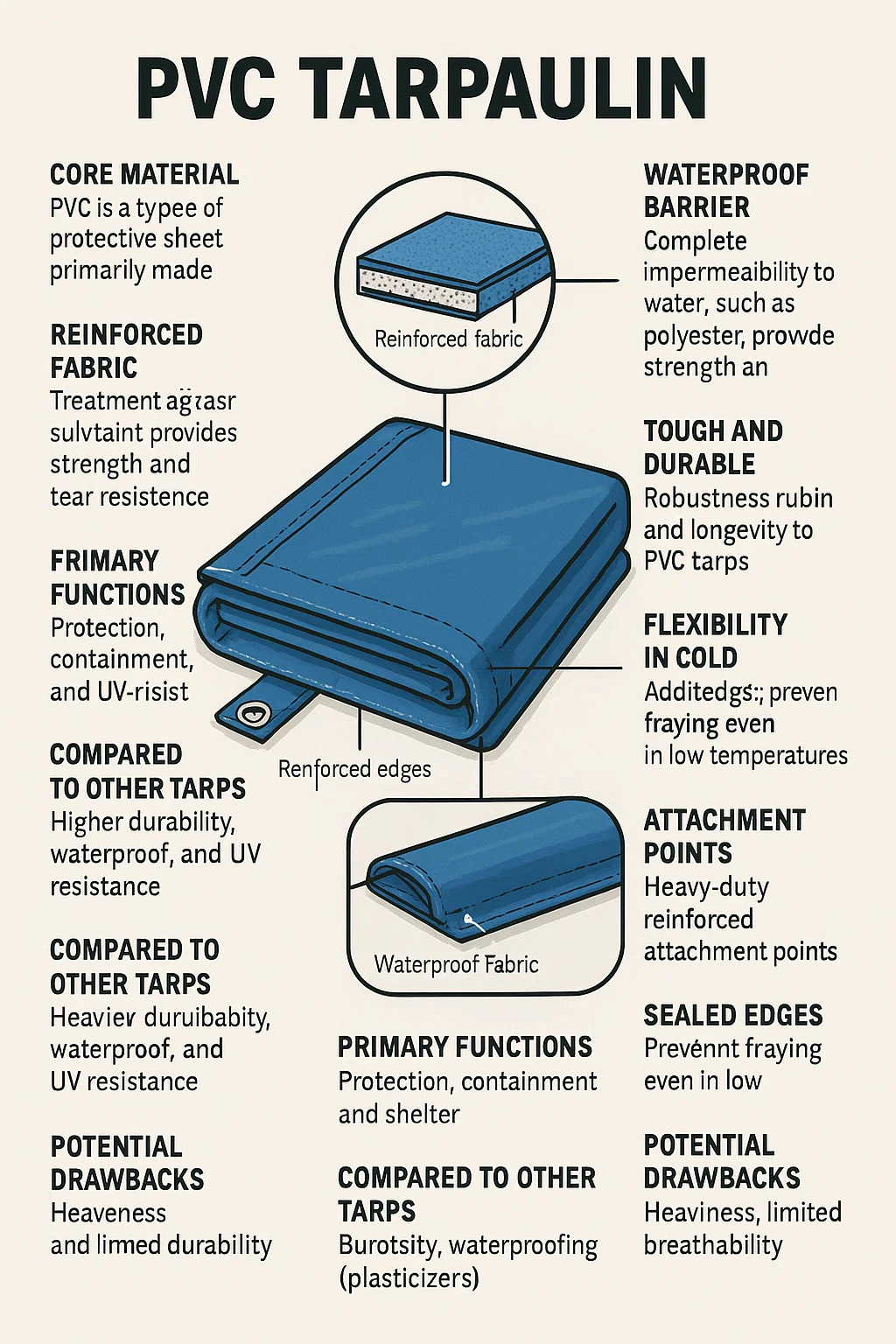Here's a point-by-point explanation of PVC tarpaulin covers, focusing on their nature and characteristics:
•Core Material: It is a type of protective sheet primarily made from Polyvinyl Chloride (PVC) plastic. This plastic forms the base layer of the material.
•Reinforced Fabric: The PVC is almost always applied as a coating or laminate onto a strong woven fabric base. Common base fabrics include polyester or nylon mesh/scrim, which provides the tarpaulin with its essential strength and tear resistance.
•Waterproof Barrier: A key feature is its complete impermeability to water. The PVC layer creates a continuous, seamless barrier that prevents any liquid from passing through, making it highly effective for rain protection and containment.
•UV Resistance: These covers are typically treated to be highly resistant to damage from sunlight (UV radiation). This treatment helps prevent the material from becoming brittle, cracking, or fading significantly when exposed to the sun for extended periods.
•Tough and Durable: PVC tarps are known for being robust and long-lasting. The combination of the strong fabric base and the resilient PVC coating makes them resistant to tearing, abrasion, punctures, and general wear and tear in demanding environments.
•Flexibility in Cold: Unlike some materials that stiffen severely in low temperatures, PVC tarpaulin generally remains relatively flexible even in cold weather, making it easier to handle and deploy year-round.
•Common Additives: During manufacturing, various additives are blended into the PVC. These can include substances to enhance fire retardancy (slowing down burning), provide fungal and mildew resistance, and improve flexibility (plasticizers).
•Sealed Edges: To maintain integrity and prevent the fabric base from fraying or wicking moisture, the edges are reinforced and sealed. This is often done with techniques like heat welding or by sewing and then covering the seams with a waterproof PVC tape.
•Attachment Points: Heavy-duty reinforced attachment points (like metal grommets, D-rings, or webbing loops) are installed along the edges. These points are crucial for securely tying down, fastening, or suspending the fastening, or suspending the cover.
•Primary Functions: PVC tarpaulins are primarily used for protection, containment, and shelter. They shield objects (like machinery, vehicles, woodpiles, or goods) from weather (rain, sun, wind), contain materials (like sand, grain, or waste), and create temporary covered areas (e.g., truck sides, construction sites, event shelters).
•Compared to Other Tarps: They are generally more durable, waterproof, and UV-resistant than polyethylene (poly) tarps, but also tend to be heavier and more expensive. They offer a different balance of properties compared to canvas or vinyl-coated polyester tarps.
•Potential Drawbacks: Some considerations include that they can be heavier than poly tarps, may have a distinctive plastic odor when new or hot, and can be less breathable, potentially trapping condensation. Recycling options can also be limited.
| Feature | Description |
| Core Material | Polyvinyl Chloride (PVC) plastic, forming the primary waterproof layer. |
| Reinforcement | Woven fabric base (e.g., polyester scrim) for strength and tear resistance. |
| Key Property | Fully waterproof barrier; prevents liquid penetration. |
| UV Resistance | Treated to resist sun damage, reducing brittleness and fading. |
| Durability | Highly resistant to tearing, abrasion, and punctures. |
| Cold Flexibility | Remains pliable in low temperatures for easier handling. |
| Common Additives | Includes fire retardants, mildew inhibitors, and plasticizers. |
| Edge Construction | Reinforced & sealed (heat-welded/taped seams) to prevent fraying/leaks. |
| Attachment Points | Reinforced grommets, D-rings, or loops for secure fastening. |
| Primary Use | Protection from weather, containment of materials, creating temporary shelter. |
| Main Advantage | Superior durability, waterproofing, and UV resistance vs. basic poly tarps. |
| Considerations | Heavier than poly tarps; may trap condensation; limited recyclability. |



 English
English Español
Español русский
русский
